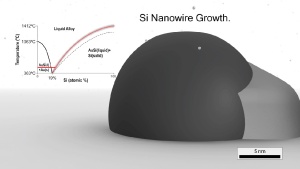Nov 23 2008
Just as artists at Disney and Pixar Animation Studios bring Mickey Mouse, Shrek and Nemo to life, life science artists are using animation to bring viruses, bacteria and even nanowires to life and demystify scientific concepts. Life science animators from Purdue Research Park-based Seyet LLC recently used their video talents to demonstrate how silicon nanowires form, a process that may change the way computers and consumer electronics are manufactured. Seyet's video provides people who don't have a medical or scientific background a "visual story" of how such complicated organisms or human-designed technologies operate.
 A frame from a Seyet LLC-generated visualization based on research by Eric Stach, a Purdue associate professor of materials engineering. The image depicts Stach's research of silicon nanowires that demonstrates how a nanowire can "nucleate," or begin to form and become a fully-functioning wire. The process may change the way computers and consumer electronics are manufactured.
A frame from a Seyet LLC-generated visualization based on research by Eric Stach, a Purdue associate professor of materials engineering. The image depicts Stach's research of silicon nanowires that demonstrates how a nanowire can "nucleate," or begin to form and become a fully-functioning wire. The process may change the way computers and consumer electronics are manufactured.
"Scientific research is becoming increasingly complex, At the same time, it is important that researchers clearly communicate new discoveries to the public," said Jon Kevan, director of research and design for Seyet LLC, a visual communication company. "The animation of the nanowires demonstrates how a silicon nanowire can 'nucleate,' or begin to form on the way to becoming wires."
Seyet specializes in translating difficult-to-grasp scientific concepts and processes into the highly accurate animated forms now demanded by specialized scientific- and technology-focused audiences, as well as regulatory agencies.
"For example, a National Science Foundation grant is reviewed first on intellectual merit and second on 'broader impacts,'" Kevan said. "Seyet's animations can help fulfill the second criteria for those broader impacts in an innovative way."
A recent video animation was designed for a research discovery by Eric Stach, a Purdue University assistant professor of materials engineering. The video describes his work with an instrument called a transmission electron microscope, which shows how nanowires develop. The research is based at IBM's Thomas J. Watson Research Center in Yorktown Heights, N.Y., and at Purdue's Birck Nanotechnology Center in the university's Discovery Park.
Stach published a paper on his research that appeared in the journal Science this month. It is the first time researchers have made such precise measurements of the nucleation process in nanowires, Stach said.
"This is very complicated science, and showing people how it works is a tremendous help in understanding it," Kevan said. "The demand for new discoveries like Eric Stach's is great, as is the need to explain, in a non-scientific way, their meaning to the public."
Stach's research is funded by the NSF's Electronic Materials Division.
Translating data into visual images, such as showing how nanowires grow, may help researchers secure funding from government and other sources, such as the National Institutes for Health, the U.S. Department of Defense and the U.S. Department of Education.
The company also developed a "Bacteriophage T4" animation for Michael Rossmann, the Hanley Distinguished Professor of Biological Sciences in Purdue's College of Science. Seyet's animation of the virus was downloaded from the Web more than 120,000 times in eight months and was among the most-viewed NSF announcements in 2004.